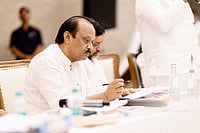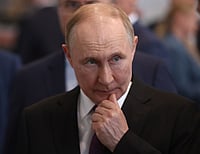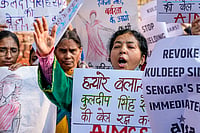Sometimes, fortune favours the not-so-brave and muddling. As a new government in May cobbled together majority support to form the 14th Lok Sabha, it was greeted by a stockmarket slide, deafening investor silence and words of doubtful encouragement from businessmen inside and outside the country. Six months later, the same laidback government, which meanwhile presented a middling budget, is greeted by a Sensex above 6200 and running, record foreign investor inflows of $8.26 billion and growth prospects of 6.5-6.8 per cent in a year that saw 13 per cent below-normal rainfall!
What on earth changed?
In an emotionally charged address at the Nehru Memorial last month, World Bank president James Wolfensohn used the sentence "We look forward to working with you" about 15 times. At the annual World Economic Forum jamboree where 400 MNCs took part, registration had to be closed an unprecedented three weeks before due to overwhelming response. Over the past two months, CEOs of giants like Intel, Microsoft, GE and venture capitalists—even Atlas Ventures' Axel Bichara—have been hopping on and off India, scouting for opportunities and promising jobs. Addressing economic editors last month, commerce minister Kamal Nath described the global oil spike as "a slight rocking of the boat" and said despite a climbing rupee, exports will touch $75 billion. Going a step ahead, finance minister P. Chidambaram declared his growth estimate for fiscal '04-05 at 6-6.5 per cent. This was corroborated last week by a senior official of the finance ministry, now working on the budget—that makes India one of the fastest growing economies in the world.
What on earth happened?
Smooth talk by politicians? Check it out with some foreign experts. Like Uri Dadush, director, World Bank Economic Policy group and author of Global Economic Prospects 2005. The gep forecasts South Asia (mainly India) to grow 6 per cent in 2004 (third highest) and higher at 6.3 per cent in 2005 (second). Says Paul A. Laudicina, VP & MD in AT Kearney's Global Business Policy Council that makes the FDI Confidence Index: "India is coming online. With both the global and domestic markets as drivers, a 6-7 per cent growth is easily possible." Adds Tarun Khanna, Harvard Business School professor: "Forget the Fortune 500. The Forbes 200 list of the world's best companies with turnovers under $1 billion has over 20 from India, all of them indigenous. To my mind, that's far more important. Chinese giants lack indigenous thinking mainly because of the cultural revolution."
Their views are echoed by analysts at home. The ICRA mid-year review, presented recently by economic advisor Saumitra Chaudhuri, dripped optimism, revising its growth forecast to 6.3 per cent, from 5.8 per cent a couple of months ago, hinting as well that 2005 would be even better at 6.8 per cent plus. While NCAER too has changed its estimate to 6.6 per cent, the Planning Commission is touting 6.8 per cent! Growth, despite the obvious Left shadow on new policy and reforms, seems to be irrepressible.
Of course, there are still those who prefer to look out of the box of political reality and lament about how much better we could have done. But, says NIPFP director M. Govinda Rao, who's also equally buoyant on growth, "The more important thing is that the government has not come in the way of the economy. Our economy is huge and most of it is outside government control. The best thing is to let it run its course and not interfere."
Growth, however, is not magic and there is no rocket science in the figures thrown around. The obvious explanation is agriculture. For one, poor kharif performance is expected to be compensated by good weather for rabi. The other is that a small (0 to 1.5 per cent) farm growth can be easily made up by galloping services (9 per cent as usual, thanks partly to government departments) and an industry buoyant for the third year (over 7. 5 per cent).
So, will the budget numbers add up better in this scenario? It really doesn't matter much to the public if the fiscal deficit (or new debt) is a few percentage points more or less. But it matters to a government which has to make the necessary public investment in areas like rural infrastructure, education, etc, not only because it has to keep the Left happy but also because it finds the need, in its enthusiasm for political PR, to present a 'human' face. Revenue figures then may not add up, that's the message that emanates from North Block.
The obvious culprits are overestimation in service taxes and import duty cuts to check inflation. However, direct tax may still perform better and make up for the indirect tax shortfall. Says the official: "Some structural changes in indirect tax patterns and direction are going to have an initial negative effect on collection. Even VAT (more correctly, a simplified general sales tax system) will not be a win-win situation."
On the other hand, inflation, mainly exogenous, seems tamed, and the oil price threat temporarily subdued. Credit offtake has spiked, over end-March to end-October, by Rs 1,17,000 crore or over three-and-a-half times compared to this seven-month period last year. In tune with the terrific macro-management of the economy, the corporate sector (including the public sector) has shown greater cost efficiency and better capital utilisation.
On the current account, invisibles are now worth more than the visibles (exports), and a cheaper dollar is making capital imports comfortable. Eighty per cent of our exports are now manufactures, most of it auto parts. Such robust growth in manufacturing indicates some, if not as robust, job creation.
What tilts the tide in India's favour is the major improvement in attitude, the optimism that businessmen reflect, the confidence they flaunt. Infosys, which took 23 years to make its first billion, hopes to make another in 23 months! A mini-boom seems to have developed, aided by a warm and liquidity-driven global climate to be sure, but a boom nonetheless. Even the conservative North Block, conceding that the capital market buoyancy surely doesn't look like a bubble, is looking for ways to utilise the vast FII component in the reserves for infrastructure, the only blot. NCAER's business confidence survey finds the highest optimism in the capital goods sector. The only downsides, if you go by the wep authors and Morgan Stanley's chief economist Stephen Roach, are the US deficit and the strong possibility of a hard landing in China. India, right now, is a growth story!
Here We Grow!
The sky-high Sensex is just a pointer; it's gung-ho time all round for Indian economy

Here We Grow!
Here We Grow!
Published At:
MOST POPULAR
WATCH
MORE FROM THE AUTHOR
×





















